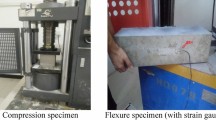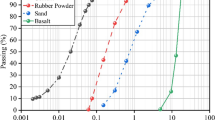Abstract
This work seeks to determine how the mesostructure of seven types of cement composites containing alumina particles or not controls their deviatoric strength, compaction law, and damage under high-pressure of confinement. First, the method of analysis of quasi-oedometric compression tests is presented. Accuracy of the method for concrete is discussed by means of numerical simulations. The confined compression tests performed show the effects of adding ceramic aggregates. Furthermore, an application of post-mortem analysis by infiltration technique of each specimen is presented, revealing a highly micro-cracked pattern depending of the mesostructure of these materials. From these observations, a discussion is presented on the influence that the addition of ceramic aggregates exerts on the confined behaviour of these composites. The tests showed a highly beneficial effect of the presence of particles, on both the deviatoric strength and the compaction law of the concretes considered.











Similar content being viewed by others
References
Malier Y (1992) Les bétons à hautes performances. In: Presses de l’Ecole Nationale des Ponts et Chaussées, France.
Cheyrezy M, Maret V, Frouin L (1995) Microstructural analysis of RPC. Cem Concr Res 257:1491–1500. doi:10.1016/0008-8846(95)00143-Z.
Darrigade A, Buzaud E (1999) High performance concrete: a numerical and experimental study. In: Proceedings of the ninth international symposium on the interactions of the effects of munitions with structures. Berlin.
Arias A, Forquin P, Zaera R, Navarro C (2008) Relationship between bending and compressive behaviour of particle-reinforced cement composites. Composites Part B. doi:10.1016/j.compositesb.2008.03.002.
Forquin P, Arias A, Zaera R (2008) Role of porosity in controlling the mechanical and impact behaviours of cement-based materials. Int J Impact Eng 353:133–146. doi:10.1016/j.ijimpeng.2007.01.002.
Clifton RJ (2000) Response of materials under dynamic loading. Int J Solids Struct 37:105–113. doi:10.1016/S0020-7683(99)00082-7.
Field JE, Walley SM, Proud WG, Goldrein HT, Siviour CR (2004) Review of experimental techniques for high rate deformation and shock studies. Int J Impact Eng 30:725–775. doi:10.1016/j.ijimpeng.2004.03.005.
Zhang MH, Shim VP, Lu G, Chew CW (2005) Resistance of high-strength concrete to projectile impact. Int J Impact Eng 31:825–841. doi:10.1016/j.ijimpeng.2004.04.009.
Barr P (1990) Guidelines for the design and assessment of concrete structures subjected to impact. Atomic Energy Authority, London.
Hanchak SJ, Forrestal MJ, Young ER, Ehrgott JQ (1992) Perforation of concrete slabs with 48 and 140 MPa unconfined compressive strength. Int J Impact Eng 121:1–7. doi:10.1016/0734-743X(92)90282-X.
Burlion N, Gatuingt F, Pijaudier-Cabot G, Daudeville L (2000) Compaction and tensile damage in concrete: constitutive modelling and application to dynamics. Comput Methods Appl Mech Eng 183:291–308. doi:10.1016/S0045-7825(99)00223-6.
Forquin P, Arias A, Zaera R (2007) An experimental method of measuring the confined compression strength of geomaterials. Int J Solids Struct 4413:4291–4317. doi:10.1016/j.ijsolstr.2006.11.022.
Yankelevsky DZ, Dancygier AN (2001) Uniaxial compressive strength effect on high velocity penetration into thick NSC and HSC targets. Symposium ISIEMS 2001.
Xu Y, Keer LM, Luk VK (1997) Elastic-cracked model for penetration into unreinforced concrete targets with ogival nose projectiles. Int J Solids Struct 3412:1479–1491. doi:10.1016/S0020-7683(96)00099-6.
Bridgman PW (1952) Studies in large plastic flow and fracture. McGraw-Hill, New York.
Paterson MS (1967) Effect of pressure on stress–strain properties of materials. Geophys J R Astron Soc 14:13–17.
Heard HA, Cline CF (1980) Mechanical behaviour of Polycrystalline BeO, Al2O3 and AlN at high pressure. J Math Sci 15:1889–1897.
Horii H, Nemat-Nasser S (1986) Brittle failure in compression: splitting, faulting and brittle-ductile transition. Philos Trans R Soc Lond 319:337–374. doi:10.1098/rsta.1986.0101.
Chen W, Ravichandran G (2000) Failure mode transition in ceramics under dynamic multiaxial compression. Int J Fract 101:141–159. doi:10.1023/A:1007672422700.
Ramsey JM, Chester FM (2004) Hybrid fracture and the transition from extension fracture to shear fracture. Nature 4286978:63–66. doi:10.1038/nature02333.
Rittel D, Brill A (2008) Dynamic flow and failure fo confined polymethylmethacrylate. J Mech Phys Solids 56:1401–1416. doi:10.1016/j.jmps.2007.09.003.
Zimmerman RG (1972) Major factors affecting the multiaxial compressive strength of plain concrete. The deformations and the rupture of solids subjected to multiaxial stresses. In: Proc. of RILEM Int Symposium, Cannes, RILEM, Paris, 1:257–272.
Palaniswamy R, Shah SP (1974) Fracture and stress–strain relationship of concrete under triaxial compression. J Struct Div ST5:901–916.
Xie J, Elwi AE, MacGregor JG (1995) Mechanical properties of three high strength concretes containing silica fume. ACI Mater J 922:135–145.
Bažant ZP, Xiang Y, Adley MD, Prat PC, Akers SA (1996) Microplane model for concrete. II: Data delocalization and verification. J Eng Mech 1223:255–262. doi:10.1061/(ASCE)0733-9399(1996)122:3(255).
Buzaud E (1998) Performances mécaniques et balistiques du microbéton MB50. In: DGA/Centre d’Etudes de Gramat Report. France.
Wallace G, Olden OJ (1965) Foundation testing techniques for arch dams and underground developments. In: ASTM STP 402.
Ma Z, Ravi-Chandar K (2000) Confined Compression: a stable homogeneous deformation for constitutive characterization. Exp Mech 40:38–45. doi:10.1007/BF02327546.
Rittel D, Hanina E, Ravichandran G (2007) A note on the direct determination of the confining pressure of cylindrical specimens. Exp Mech. doi:10.1007/s11340-007-9070-8.
Huang C, Subhans G (2003) Influence of lateral confinement on dynamic damage evolution during uniaxial compressive response of brittle solids. J Mech Phys Solids 51:1089–1105. doi:10.1016/S0022-5096(03)00002-4.
Bardia P, Narasimhan R (2006) Characterization of pressure-sensitive yielding in polymers. Strain 42:187–196. doi:10.1111/j.1475-1305.2006.00272.x.
Gatuingt F (1999) Prévision de la rupture des ouvrages en béton sollicités en dynamique rapide. In: Ph.D. Thesis, Ecole Normale Supérieure de Cachan, France.
Burlion N, Pijaudier-Cabot G, Dahan N (2001) Experimental analysis of compaction of concrete and mortar. Int J Numer Anal Methods Geomech 25:1467–1486. doi:10.1002/nag.178.
Forquin P, Gary G, Gatuingt F (2008) A testing technique for concrete under confinement at high rates of strain. Int J Impact Eng 356:425–446. doi:10.1016/j.ijimpeng.2007.04.007.
Holmquist TJ, Johnson GR, Cook WH (1993) A computational constitutive model for concrete subjected to large strains, high strain rates, and high pressures. In: Proceedings of the fourteenth international symposium on the ballistics. Quebec.
Jovicic J, Zavaliangos A, Ko F (2000) Modeling of the ballistic behavior of gradient design composite armors. Compos Part A 31:773–784. doi:10.1016/S1359-835X(00)00028-2.
Arias A, Zaera R, López-Puente J, Navarro C (2003) Numerical modeling of the impact behavior of new particulate-loaded composite materials. Compos Struct 611:151–159. doi:10.1016/S0263-8223(03)00038-2.
Hibbitt HD, Karlsson BI, Sorensen P (2003) Abaqus user’s manual, ABAQUS/STANDARD.
Hibbitt HD, Karlsson BI, Sorensen P (2003) Abaqus user’s manual, ABAQUS/EXPLICIT.
Krieg RD (1978) A simple constitutive description for soils and crushable foams. In: SC-DR-7260883, Sandia National Laboratory. Report, USA.
Swenson DV, Taylor LM (1983) A finite element model for the analysis of tailored pulse stimulation of boreholes. Int J Numer Anal Methods Geomech 7:469–484. doi:10.1002/nag.1610070408.
Lankford J (1981) Temperature-strain rate dependence of compressive strength and damage mechanisms in aluminium oxide. J Mater Sci 16:1567–1578. doi:10.1007/BF02396874.
Forquin P (2003) Endommagement et fissuration de matériaux fragiles sous impact balistique, rôle de la microstructure. In: PhD Thesis, Ecole Normale Supérieure de Cachan, France.
Forquin P, Hild F (2007) Dynamic fragmentation of an ultra-high strength concrete during edge-on impact tests. J Eng Mech 1344:302–315. doi:10.1061/(ASCE)0733-9399(2008)134:4(302).
Acknowledgements
The authors are indebted to the Spanish Comisión Interministerial de Ciencia y Tecnología (Project MAT2002-03339), to the Comunidad Autónoma de Madrid and the University Carlos III of Madrid (CCG06-UC3M/DPI-0796 and CCG07-UC3M/DPI-3395) for the financial support of this work. To the Délégation Générale pour l’Armement (DGA/France) for the mobility grant provided to Dr. Forquin.
Author information
Authors and Affiliations
Corresponding author
Rights and permissions
About this article
Cite this article
Forquin, P., Arias, A. & Zaera, R. Relationship Between Mesostructure, Mechanical Behaviour and Damage of Cement Composites Under High-Pressure Confinement. Exp Mech 49, 613–625 (2009). https://doi.org/10.1007/s11340-008-9172-y
Received:
Accepted:
Published:
Issue Date:
DOI: https://doi.org/10.1007/s11340-008-9172-y




